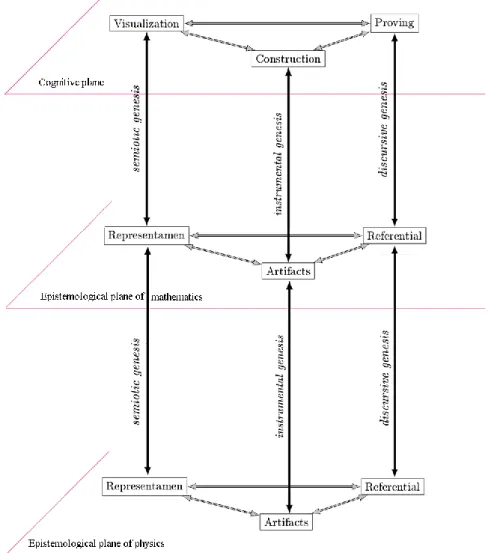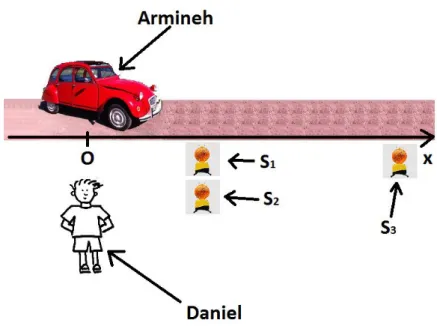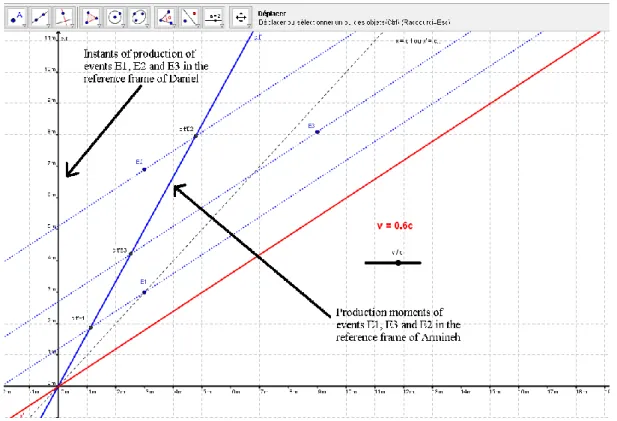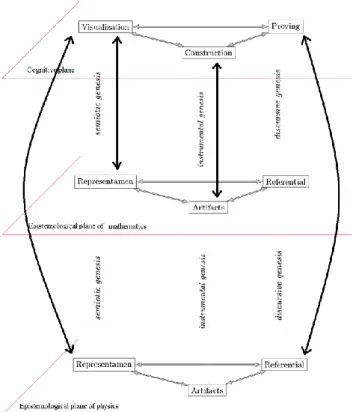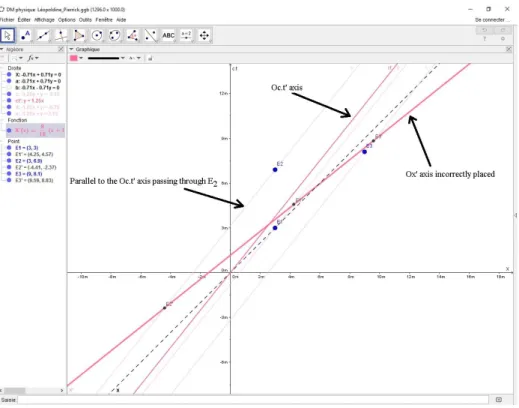HAL Id: hal-02408955
https://hal.archives-ouvertes.fr/hal-02408955
Submitted on 13 Dec 2019HAL is a multi-disciplinary open access archive for the deposit and dissemination of sci-entific research documents, whether they are pub-lished or not. The documents may come from teaching and research institutions in France or abroad, or from public or private research centers.
L’archive ouverte pluridisciplinaire HAL, est destinée au dépôt et à la diffusion de documents scientifiques de niveau recherche, publiés ou non, émanant des établissements d’enseignement et de recherche français ou étrangers, des laboratoires publics ou privés.
The extended theoretical framework of Mathematical
Working Space (extended MWS): Potentialities in
physics
Laurent Moutet
To cite this version:
Laurent Moutet. The extended theoretical framework of Mathematical Working Space (extended MWS): Potentialities in physics. Eleventh Congress of the European Society for Research in Mathe-matics Education, Utrecht University, Feb 2019, Utrecht, Netherlands. �hal-02408955�
The extended theoretical framework of Mathematical Working Space
(extended MWS): Potentialities in physics
Laurent Moutet1
1
Laboratoire de Didactique André Revuz, UFR de mathématiques, Université Paris Diderot, Paris, France; laurent.moutet@ac-amiens.fr
The aim is to show how the extended Mathematical Working Space (extended MWS) theoretical framework makes it possible to analyse the tasks implemented during a few stages of a modelling cycle in physics. The study begins with a special relativity teaching sequence using a diagrammatic approach in “Terminale S” in France (Grade 12). The analysis using the extended MWS theoretical framework allows to highlight the learning advantages of this diagrammatic approach during a complete didactic engineering. This work is proposed for TWG6 to CERME11.
Keywords: Mathematics, physics, extended MWS, modelling.
Presentation of the extended MWS theoretical framework
The Mathematical Working space (MWS) was developed to better understand the didactic issues around mathematical work in a school environment by Kuzniak, Tanguay, and Elia (2016). The MWS has two levels: one of a cognitive nature in relation to the student and another of an epistemological nature in relation to the mathematical content studied. The epistemological plane contains a set of representations (signs used), a set of artefacts (drawing instruments or software) and a theoretical reference set (definitions and properties). The cognitive plane contains a visualization process (representation of space in the case of geometry), a construction process (function of the tools used) and a discursive process (arguments and evidence). Mathematical work results from an articulation between the cognitive and epistemological planes through instrumental genesis (operationalization of artefacts), semiotic genesis (based on the register of semiotic representations) and discursive genesis (presentation of mathematical reasoning). The different phases of mathematical work associated with a task can be highlighted by representing three vertical planes on the ETM diagram. Semiotic-instrumental interactions lead to a process of discovery and exploration of a given academic problem. Those of an instrumental-discursive type favour mathematical reasoning in relation to experimental evidence. Finally, those of the semiotic-discursive type are characteristic of the communication of mathematical results as well as of more elaborate reasoning. The MWS diagram was transformed by Moutet (2018) by adding an epistemological plane corresponding to the rationality framework of physics (Figure 1). It was chosen to keep only one cognitive plane. We hypothesized that students’ conceptions in mathematics and physics can be highlighted using a students’ personal extended MWS. The functioning of the schemes (Vergnaud, 2013) specific to these conceptions could appear during the activation of the various geneses. The Concepts in mathematics would be highlighted by the activation of geneses, between the cognitive plane and the epistemological plane of mathematics, those in physics would be highlighted by the activation of geneses, between the same cognitive plane and the epistemological plane of physics. A single cognitive plane would therefore be
sufficient to describe conceptions in mathematics, physics and to analyse student tasks from both a mathematics and a physics perspective. The term “proving” is retained, but in the case of the extended MWS, it will take a narrower meaning of justification or reasoning. The extended MWS framework makes it possible to analyse in detail the interactions between the various rationality frameworks, and the student’s cognitive plane and then to qualify the nature of the work accomplished by the student.
The epistemological plane of mathematics studied here concerns Euclidean geometry. The tasks to be carried out are associated with the construction of lines, segments, symmetries parallel to a line, projections passing through a point and parallel to an axis. The epistemological plane of physics is associated with the reference frame of special relativity studied in class. These are the notion of the Galilean reference frame (two reference frames moving in a straight line and at a constant speed with respect to each other), of an event (a point located on a space-time diagram and associated with a position x and a time t), of Einstein’s two postulates, of the notion of proper duration and improper duration as well as the relationship of dilation of durations. Lorentz transformations are not studied in Grade 12.
From the “model situation” to the “real results” during a special relativity
modelling
A teaching sequence developed by Moutet (2018) is destined for students in “Terminale S” (Grade 12) on the topic of special relativity following the work of de Hosson, Kermen, and Parizot (2010). It follows the learning of the course, and the correction of exercises in the manual, and participates in the conceptualisation of notions of special relativity, by allowing them to be reinvested in a different and unknown context (Vergnaud, 1990).
Two research questions guided this work: 1) How does the extended MWS framework allow the analysis of the sets of rationality frameworks between mathematics and physics during a sequence dealing with special relativity with “Terminale S” students via a geometric approach? 2) To what extent does the analysis of the use of dynamic geometry software by the extended MWS framework show that it promotes conceptualisation in students?
The teaching sequence can be described in the following context: Armineh drives a car moving at a speed v near the speed of light relative to Daniel. The latter is on the roadside next to three flash lights S1, S2 and S3 associated with three events E1, E2, E3 and initially known in Daniel's reference
frame (Figure 2). An event Ei corresponds to a coordinate point (xi, c.ti) in the Minkowski
space-time diagram. S1 and S2 have the same position in Daniel's reference frame.
Figure 2: The “real model” of the situation
We can use the modelling cycle proposed by Blum and Leiss (2005) to position the teaching sequence on the chronological order of events as a function of the reference frame in the context of special relativity. We carried out a preliminary study of a sequence by studying the passage real model → real results with the objective of developing a longer-term sequence covering a complete modelling cycle real situation → real results. In this case, it will not be appropriate to use a “2CV” as a vehicle to favour the passages real situation → situation model and situation model → mathematical results.
We can also take the point of view of Vince and Tiberghien (2000) who studied the articulation between the world of objects and events and that of theories and models in the physical sciences. The objects resulting from the simulation are observable and can be manipulated. They are not real objects or elements of the world of theories and models. They act as intermediaries, facilitating the transition, through the problem-solving activity, between the world of objects/events and the world of models.
The Minkowski diagram is a space-time diagram allowing to know the space-time coordinates of an event in a reference frame of Armineh or Daniel. In the Minkowski diagram, the line x = 0 is described by the axis (Oc.t) in the Daniel reference frame. Similarly, the line x' = 0 is described by the axis (Oc.t’) in the Armineh reference frame. c is the speed of light in vacuum or air. Projections on this type of diagram are made parallel to the axes. The axis (Ox') is the symmetric of the axis (Oc.t') with respect to the line x = c.t. It is the same for the axes (Ox) and (Oc.t).
The dynamic geometry software GeoGebra and the Minkowski space-time diagram were used by the students. It represents the reference frame (xOc.t) relative to Daniel's reference frame and the reference frame (x’Oc.t') relative to Armineh's reference frame. The latter moves at the speed v of 0.6 times the speed of light in vacuum with respect to Daniel along an axis (Ox). The straight lines (Ox) or (Ox') correspond to the route in Daniel’s or Armineh’s reference frames (Figure 3).
With respect to Daniel, the chronological order of production of the three events is E1, E2 and E3
while with respect to Armineh the order is E1, E3 and E2. The GeoGebra cursor allows to modify the
experimental conditions by changing the speed v and thus observe a change of chronological order of events production in the Armineh frame of reference. The corrected activity file with the Minkowski diagram is available by clicking on the following hyperlink:
https://drive.google.com/open?id=0B_f8SgBLz2P0N0xfazFCSmU3MHM
The epistemological plane of mathematics and the cognitive plane are mobilised during the construction of the cursor because it is necessary to know how the Ox' and Oc.t' axes are modified according to the speed v. The two axes are symmetric with respect to the line x' = c.t' which is also confounded with the line x = c.t. The epistemological plane of physics is also mobilised when the students conclude on the chronological order of events according to the two reference frames (Figure 4).
A class of 34 students from a secondary school in Picardy participated in the experiment. A first paper-pencil session was performed to construct and use the Minkowski diagram with strong teacher guidance. The work focused on the phenomena of time dilation for a given speed from one reference frame to another. The activity, corresponding to the second session, was then given to groups as a homework. The speed conditions were different from one group to another. The students had to model in autonomy the situation where the speed of one reference frame compared to another is modified and close to the speed of light. It was therefore necessary to use dynamic geometry software in autonomy, build the dynamic Minkowski diagram and deduce results on the chronological order of events according to the reference frames. Most students had not used GeoGebra software in high school. The students completed a first version of their homework assignments, and then worked for two hours in half class in the computer room to finalise their
GeoGebra file. Each student also made an MP3 recording to summarize the entire sequence, which totalled five hours. The work of four students was analysed, and they were selected based on their academic performance (success and difficult students).
Figure 3: The mathematical model of the situation
With the MWS extended model we can perform a priori analysis of each of the tasks to be executed by the students. The level of difficulty of each task, can be appreciated by looking at the portion of the genesis instrumental-discursive or semiotic-discursive, more difficult, compared to the genesis semiotic-instrumental. A posteriori analyses allow us to study the tasks assigned to the students, and those carried out by them, considering the rationality frameworks of mathematics and physics. This study focused on the links between epistemological and cognitive planes. It led to the identification of the sets of rationality frameworks when solving this problem of special relativity treated by a diagrammatic approach. The dynamic geometry software GeoGebra allows to perform an additional semiotic genesis with its dynamic aspect. The cursor allows the speed conditions to change from one reference frame to another and the student can see the results directly on the screen. An instrumental genesis different from the paper-pencil activity, is also used during the construction of the Minkowski diagram. Finally, we hypothesise that GeoGebra, by making it easier to make conclusions about the relative chronological order of events, leads to the activation of an original discursive genesis. The audio recording, which the students made to summarise all the tasks performed during this sequence, allows them to communicate on the Minkowski diagram without directly implementing it. It is the sign of semiotic and discursive interactions favouring a conceptualisation of notions of special relativity.
Figure 4: A priori analysis of cursor usage with GeoGebra
Student B’s work is presented here. The Minkowski diagram includes the three events, the Ox, Oc.t, Oc.t' axes, the x = c.t line, and projections parallel to the Oc.t’ axis cutting an Ox' axis that is not correctly positioned. Also, the cursor does not appear. The notion of event seems to be mobilised as well as that of reference frame since the two reference points appear explicitly even if it remains imperfect. The notion of relative chronological order does not seem to be a well-known one (Figure 5).
The second version which has been reworked in class (personalised help from the teacher to give technical information on the cursor and on the meanings of the lines x = c.t. or x' = c.t') includes the different elements which were missing in the first version. The Ox' axis is well positioned, the cursor for changing the v/c value appears and the c.t coordinates of the different events also. Parallels to the Oc.t' axis or to the Ox' axis passing through the different events are also represented. This work highlights tasks described by semiotic-instrumental interactions, properly performed by Student B and more marginally tasks described by instrumental-discursive interactions. Important confusions are shown in the audio recording, on the construction of the line O.ct' with an incorrect coefficient director (coefficient director of 0.6 instead of 1/0.6 when v = 0.6.c). This recording also shows that Student B is saying results without using the Minkowski diagram or in a basic way. There is confusion about the goal of the activity (comparing speeds from Student B), or about the notion of the speed of a system in a given reference frame (Student B speaks rather of the speed of a reference frame). The explanations of the plot of the line x = c.t. are ambiguous as the positions of the c.t' coordinates of the various events (Figure 6).
Figure 5: Screenshot of the first GeoGebra version of Student B
Figure 6: A posteriori analysis of the tasks performed by Student B
The black arrows describe a genesis on the extended MWS corresponding to a correctly performed task, the black arrows crossed out an incorrectly performed task and the dotted arrows, a partially successful task.
Conclusion
The extended MWS framework, allowed us to analyse the tasks associated with certain stages of the modelling cycle in a problem involving special relativity. It considers the mobilisation of the epistemological planes of mathematics, and/or physics for each of the tasks requested. The extended MWS framework also led us to show that the GeoGebra software develops specific geneses in relation to a paper-pencil activity. A new semiotic genesis leads to a visualisation of the change in the time coordinates of events as a function of Armineh’s speed v with respect to Daniel. A new
instrumental genesis corresponds to the manipulation of the dynamic geometry software, with the cursor functionality allowing to simply change the experimental conditions. Finally, a new discursive genesis makes it possible to conclude on the chronological order of events, according to the reference frame of study and the speed v. The extended MWS model leads to an a priori analysis of each of the tasks to be performed by the students and to a successful a posteriori analysis of the work performed by them. We then plan to analyse, using the extended MWS model or one of its evolutions, the tasks implemented at each stage of the global modelling cycle during other sequences using special relativity. Preliminary results tend to show that the genesis as well as the epistemological plans of mathematics and physics are not mobilised in the same way according to the stage of the modelling cycle, and that the teacher often, assumes implicitly an important part of the stages of the modelling cycle (we suppose an important assumption of responsibility for the stages going from the real situation to the real model), which does not help “in our opinion” the students to understand the problems which are given to them. Problem-solving exercises allow this understanding, but it takes time to complete. We plan to carry out the same study from the point of view of the theory of both worlds, that of objects/events and theories/models. It would thus be possible to finely analyse the passage between the two worlds via the simulated world using the extended MWS model.
Acknowledgement
I would like to thank all the members of the LDAR MWS working group.
References
Blum, W., & Leiss, D. (2005). „Filling Up “– the problem of independence-preserving teacher interventions in lessons with demanding modelling tasks. In M. Bosch (Ed.), Proceedings of the Fourth Congress of the European Society for Research in Mathematics Education (pp. 1623– 1633). Sant Feliu de Guíxols, Spain: FUNDEMI IQS – Universitat Ramon Llull and ERME. de Hosson, C., Kermen, I., & Parizot, E. (2010). Exploring students’ understanding of reference
frames and time in Galilean and special relativity. European Journal of Physics, 31(6), 1527– 1538.
Kuzniak, A., Tanguay, D., & Elia, I. (2016). Mathematical working spaces in schooling: An introduction. ZDM Mathematics Education, 48(6), 721–737.
Vince, J., & Tiberghien, A. (2000). Simuler pour modéliser. Le cas du son. Sciences et techniques de l’Information et de la Communication pour l’Éducation et la Formation, 7(2), 333–366. Moutet, L. (2018). Analyse d’une séquence d’enseignement de la relativité restreinte: L’apport du
modèle de l’ETM étendu. Annales de didactique et de sciences cognitives, 23, 107–136.
Vergnaud, G. (2013). Pourquoi la théorie des champs conceptuels ? Infancia y aprendizaje, 36(2), 131–161.
Vergnaud, G. (1990). La théorie des champs conceptuels. Recherches en Didactique des Mathématiques, 10(2-3), 133–170.
